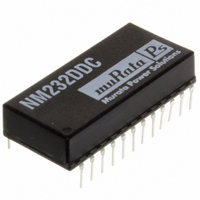NM232DDC Murata Power Solutions Inc, NM232DDC Datasheet

NM232DDC
Specifications of NM232DDC
Available stocks
Related parts for NM232DDC
NM232DDC Summary of contents
Page 1
... EIA-232-D/E and CCITT V.28 compatible Dual transmitters and receivers 1.5kVrms Isolation DESCRIPTION The NM232DDC is an electrically isolated dual transmitter and receiver designed to inter- face data terminal equipment (DTE) with data communications equipment (DCE). The device provides two data receive channels and two data transmit channels ...
Page 2
... Where to use the NM232DDC The function of the NM232DDC is to provide an isolated signal path between a UART or similar device and the EIA-232-D interface ‘D’ connector, providing two receivers and two transmitters which can be used in a number of handshake modes ...
Page 3
... POWER UP TO TRANSMITTER OUTPUT DELAY TRANSMITTER SLEW RATE VS LOAD CAPACITANCE ENABLE & DISABLE TIMES VS TEMPERATURE www.murata-ps.com Isolated Dual EIA-232-D Transmitter and Receiver SHUTDOWN TO POWER UP DELAY TRANSMITTER SLEW RATE VS TEMPERATURE PROPAGATION DELAY VS TEMPERATURE Technical enquiries - email: mk@murata-ps.com, tel: NM232DDC +44 (0)1908 615232 KII_NM232DDC.A02 Page ...
Page 4
... Isolated Dual EIA-232-D Transmitter and Receiver 0.012 (0.30) 0.008 (0.20) 0.6673 (16.95) MAX RECOMMENDED FOOTPRINT All dimensions are in inches (mm) ±0.01 (0.25) , low-normal operation OUT TUBE OUTLINE DIMENSIONS All dimensions are in inches (mm) ±0.01 (0.25) Technical enquiries - email: mk@murata-ps.com, tel: NM232DDC Tube Quantity : 15 +44 (0)1908 615232 KII_NM232DDC.A02 Page ...
Page 5
... A question commonly asked is, “What is the continuous voltage that can be applied across the part in normal operation?” For a part holding no specific agency approvals, such as the NM232DDC series, both input and output should normally be maintained within SELV limits i.e. less than 42.4V peak, or 60VDC. The isolation test voltage represents a measure of immunity to transient voltages and the part should never be used as an element of a safety isolation system. The part could be expected to function correctly with several hundred volts offset applied continuously across the isolation barrier ...

















